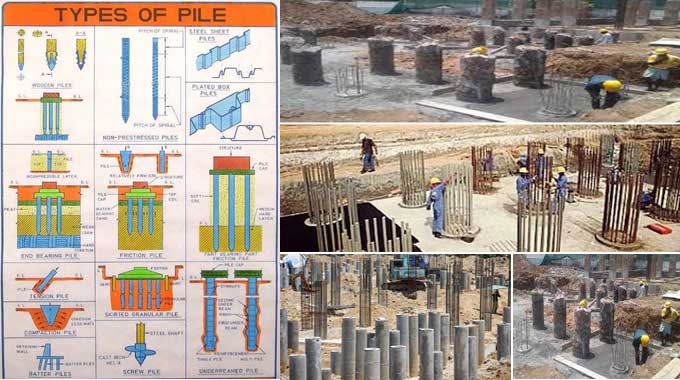
Design and Types of Piles & its Foundation: Everything you need to know
The main function of a pile is to support the structures built on top of it, and it consists of a long cylinder made from a strong material such as concrete.
Pile Testing
A trial pile that is close to the actual foundations but does not form part of it should be formed for testing at least one pile per scheme. It recommends that the pile overloads by at least 50% of its working load and is held for 24 hours. It allows not only for proper pile construction but also for the pile to support its weight.
Methods of Pile Testing
It is still possible to evaluate pile capacity while taking soil skin friction into account. A pile's capacity should calculate when the skin friction is negative. Geotechnical investigations usually determine the allowable end bearing and skin friction.
There is an allowance for net bearing and skin friction in the report. According to the geotechnical investigation report, the ultimate end bearing and ultimate skin friction should be converted into allowable capacities based on the working loads of the structure.
Types of Piles
Bored Piles
A bored pile is constructed by excavating spoil to create a hole where the pile will pour in situ. When constructing pile foundations near existing buildings, friction piles are used primarily in cohesive sub-soils. They are more common in urban areas because there is little vibration, they can use in locations with limited headroom, there is no risk of heaving, and they can vary in length. The most common use for bored piles is deep foundations since shallow foundations cannot meet axial capacity requirements.
Driven Piles
When passing through a driven pile, the material around the shaft displaces outwards and downwards rather than removed. In offshore applications, driven piles are stable, can density lose soil, and are useful in soft squeezing soils.
Geothermal Piles
With closed-loop ground-source heat pump systems, this type of pile combines pile foundations with piles. A structure's foundation makes up these elements, which also act as a heat source and a heat sink.
By storing heat from cooling systems in the ground, the ground can warm a building in winter since the thermal mass of the ground can store heat. It usually consists of horizontal or vertical underground pipes that extract heat from the ground. A geothermal pile contains vertical pipe loops within the pile itself.
Micro Piles
These kinds of piles are commonly used in areas with limited access, such as underpinning settlement-prone structures. You can drive or screw these types of piles into place.
Definition of Pile Foundation
A pile foundation is a deep foundation. Steel or reinforced concrete columnar elements, or sometimes timber, uses to construct them. Piled foundations define as those whose depth exceeds their breadth by three times.
Purpose of Pile Foundation
Pile foundations must pass through weak compressible strata or water so that loads can be transferred to stronger, less compressible, and stiffer soils at depth. These stronger soils can then support horizontal loads. It is necessary for large structures and in situations where soil cannot rely upon them to prevent excessive settlement.
Wrapping it Up
When designing piles, end bearing, and skin friction calculate. Your ability to estimate the pile's capacity is easy if you can calculate the above parameters. Consequently, foundation system design is an engineering process that requires simplifying complex models. In the design of pile foundations, it is always necessary to calculate the axial bearing capacity of each pile.
To get more details, watch the following video tutorial.
Video Source: Civil Engineering


